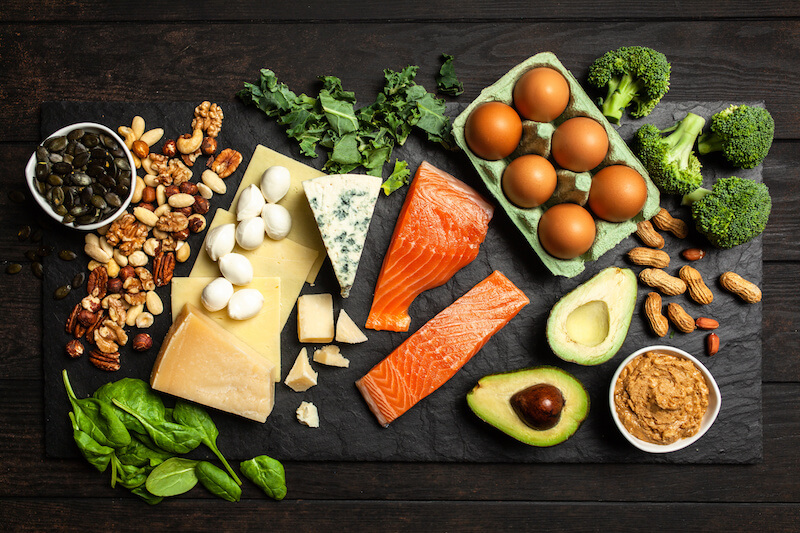Are keto and low-carb diets the same? They’re similar in that they both restrict carbohydrates, but when carried out, the body reacts to them very differently.
If you’re confused by this, you’re not alone.
There’s a lot of conflicting information on the internet that puts these two diets in the same box. But don’t fret! We’ll get into the nitty-gritty of what makes Keto Zone and low-carb regimens different and which one could be best for your needs.
The Basics
Let’s compare the fundamentals of these two diets.
Keto:
When implemented properly, keto refers to altering your metabolic state to burn fat for fuel instead of using glucose, otherwise known as carbohydrates.
This state is called ketosis, and to reach it, you must be consuming minimal carbs, adequate amounts of protein, and very high amounts of healthy fat. You should be eating less than 20 grams of carbohydrates per day to get into and stay in the Keto Zone.
Low-Carb:
Although there are many different ways to go about a low-carb diet, it solely refers to restricting the number of carbohydrates consumed, mainly from grains, potatoes, added sugars, and junk food.
Usually, this results in eating a diet higher in protein and healthy fats. The typical amount of recommended carbs to consume per day is around 50-100 grams, which is a significantly higher amount than keto and doesn’t regularly result in reaching ketosis. (1)
Allowed Foods
What can you eat on keto vs. on a low-carb diet?
Keto:
- Meats
- Fish
- Vegetables: Except for root vegetables like potatoes and beets
- Dairy: Organic cheese, heavy cream, eggs, sour cream, grass-fed butter, Greek yogurt
- Fruits: Avocados, blueberries, blackberries, strawberries, raspberries, and olives
- Nuts: Almonds, pecans, macadamia nuts, peanuts, and walnuts
- Fats/Oils: MCT Oil Powder, avocado oil, olive oil, coconut oil, almond oil
Nut milk like almond and coconut are also keto-friendly, as well as coffee, tea, sea salt, and nut flours.
Low-Carb:
On a low-carb diet, you have more of a variety of food choices. As long as you stay away from heavy-carb foods like bread, pasta, and processed foods and don’t go above 100 grams of carbs per day, you’re essentially following a low-carb diet.
However, most of them look like this:
- Meat
- Fish
- Eggs
- Nuts
- Seeds
- Vegetables
- Fruit
- Healthy Fats
The Benefits
Down to the benefits! Which one offers more?
Keto:
The most obvious advantage of keto is weight loss. If your body is in the Keto Zone, you’re burning fat and curbing appetite while shedding pounds. (2, 3, 4) The diet also improves cholesterol, adds relief to those with inflammatory conditions like psoriasis and eczema, and helps regulate blood sugar for those with Type 2 diabetes. (5, 6, 7, 8, 9, 10)
To top it off, studies have shown that the keto diet can prevent and slow down cancer growth, add relief to those with Alzheimer’s, dementia, and bipolar disorder, and clear brain fog. (11, 12, 13, 14)
In fact, when it was first introduced 100 years ago, it was used as a relief treatment for children with epilepsy, and it was proven to show positive results. (15, 16) Check out The 7 Most Powerful Benefits of the Keto Diet for more in-depth descriptions of these benefits.
Low-Carb:
Weight loss can be a benefit to low-carb diets as you cut out excess sugar and processed foods, although it’s not usually as effective as getting into the Keto Zone where you burn fat for fuel. (17, 18)
For some, however, low-carb diets can be easier to maintain because they’re less restrictive. They may also be a good way to ease into the keto diet, as you get used to eating fewer carbohydrates.
Bottom Line
Although more restrictive, keto offers more health benefits than low-carb diets, especially for those looking to lose weight and regulate blood sugar and inflammatory symptoms.
Is this you? If so, try Keto Zone today!

Leave a Reply